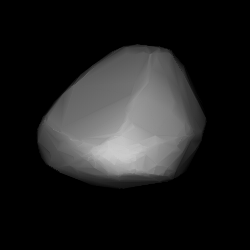 Modelled shape of Ruperto-Carola | |
| Discovery | |
|---|---|
| Discovered by | Max Wolf |
| Discovery date | 16 January 1893 |
| Designations | |
| (353) Ruperto-Carola | |
Named after | Ruprecht Karls University |
| 1893 F · A893 BB | |
| Main belt | |
| Orbital characteristics[1] | |
| Epoch 31 July 2016 (JD 2457600.5) | |
| Uncertainty parameter 0 | |
| Observation arc | 123.20 yr (44997 d) |
| Aphelion | 3.63014 AU (543.061 Gm) |
| Perihelion | 1.84116 AU (275.434 Gm) |
| 2.73565 AU (409.247 Gm) | |
| Eccentricity | 0.32697 |
| 4.52 yr (1652.7 d) | |
| 145.519° | |
| 0° 13m 4.177s / day | |
| Inclination | 5.70668° |
| 102.486° | |
| 321.460° | |
| Physical characteristics | |
| 14.025±0.784 km | |
| 2.73898 h | |
| 11.0 | |
353 Ruperto-Carola (prov. designation: A893 BB or 1893 F) is a background asteroid from the central region of the asteroid belt.[1] It was discovered by German astronomer Max Wolf at the Heidelberg Observatory on 16 January 1893. It is named after the Ruprecht Karls University (University of Heidelberg), whose Latin name is Ruperto Carola Heidelbergensis.
- ^ a b "353 Ruperto-Carola (1893 F)". JPL Small-Body Database. NASA/Jet Propulsion Laboratory. Archived from the original on 20 August 2020. Retrieved 11 May 2016.